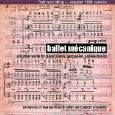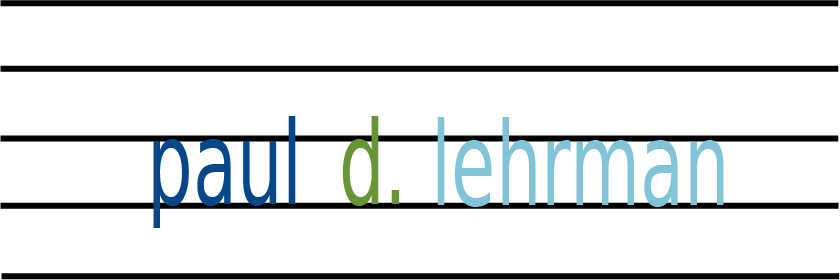About Paul
The Back Story—who is this guy?I got involved in electronic music in high school on Long Island, when I built my first theremin from a kit (it didn’t work very well) and produced tape collages in my parents’ living room with a Steinway piano, a Hagstrom electric guitar, a Sony 3-head reel-to-reel tape deck, and two Lafayette Radio microphones. I don’t have the mics any more and the piano is with another family member, but I still have the tape deck and the guitar (which still works).
I was also active in jazz, classical, choral, and rock-and-roll ensembles, playing alto and baritone sax, bassoon, guitar, acoustic and electric bass, drums, orchestral and mallet percussion, and keyboards. My taste at various times ran to Varèse, the Beatles, the Jefferson Airplane, the Incredible String Band, Frank Zappa, Tom Lehrer, the Grateful Dead, the Byrds, the Chad Mitchell Trio, Pentangle, the Doors, the Lovin’ Spoonful, Dave Brubeck, Charlie Parker, Stravinsky, Hindemith, Mozart, and Luciano Berio. And I was at Woodstock, although not for very long (the story is in my book).
The best summers of my life were spent at the University of Vermont Summer Music Session for High School Students in Burlington. Unfortunately, this program is no longer in existence, but it was a terrific low-cost music camp, on a pretty, urban college campus, for talented kids from all over. There I was exposed to modern composers like Hovhaness, Holst, Bielawa, Haufrecht, and Copland, and also played the music of Dizzy Gillespie, Mendelssohn, and Leonard Bernstein, and sang in a madrigal group as well as an absolutely magical performance of Mozart’s Missa Brevis in F.
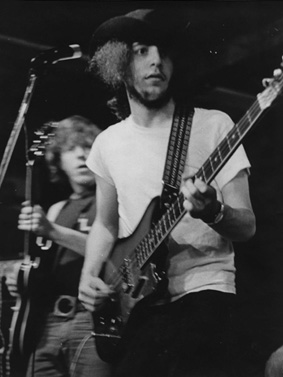
In 1971 at the height of my rock and roll career. (Note cheap Japanese bass.)
I had the privilege of studying electronic music composition at Columbia University with Vladimir Ussachevsky, Mario Davidovsky, and Charles Dodge. I left Columbia after two years, however, and went off to live on a doomed-to-failure hippie commune in Nelson County, Virginia, whose primary export is poverty. After coming back to New York, I enrolled in the Conservatory of Music at the State University of New York at Purchase (a/k/a Purchase College, alma mater of Wesley Snipes, Stanley Tucci, Parker Posey, Ving Rhames, and most of the cast of The Sopranos), where my teachers included bassoonists William Polisi (whom I met at the UVM Summer Session, and studied with for the next seven years) and Donald MacCourt, theorist and pianist Robert Levin, composer Alvin Brehm, organist Anthony Newman, and percussionist Raymond DesRoches. My B.F.A. is in orchestral performance as a bassoonist and contrabassoonist, and I was in the first class to graduate from the music program.
Over the next several years I played in bands, taught in music camps and schools, musically directed many professional and community theater productions, wrote songs and musical comedies, and worked as a recording, production, and maintenance engineer for radio stations WNCN, WCRB, and WHET. I also began my writing career by penning record reviews for Keynotes, the WNCN program guide. I moved to the Boston area in 1977, and shortly thereafter became a regular contributor to the Boston Phoenix (R.I.P.)
In 1979, I was hired to be chief engineer at the brand-new Storyk-designed Sharc Studios in Trinidad, on a high hill overlooking beautiful Chaguaramas Bay. It was the first locally-owned 24-track recording studio in the Caribbean. I only lasted a few months, however, and the studio didn’t last much longer, a victim of its owner’s greed and incompetence. My various adventures and misadventures in that position have become fodder for a number of articles in the years since.
In 1980, I began a long-time association with Studio Sound magazine in England, and also Recording Engineer/Producer in Los Angeles, for whom I was a columnist — “Managing MIDI” — from 1986 to 1989.
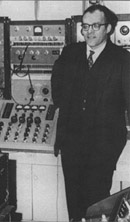
Vladimir Ussachevsky
In 1982, on an assignment for the Phoenix, I interviewed a number of users of the alphaSyntauri computer music system, a synthesis and sequencing system for Apple ][ computers. I acquired a system of my own (selling my Fender Rhodes 88 to be able to buy the computer) and became involved with the manufacturer as a consultant and alpha-tester. I wrote my own software for the system, a visual waveform editing program called “Metawave“, which was featured in the October, 1984, issue of Mix magazine. I also used the system for my first film score, a documentary for the Massachusetts Audobon Society.
In 1984, I was invited to join Southworth Music Systems, where I co-designed the first graphic-oriented MIDI sequencer for the brand-new Apple Macintosh, called Total Music. I served as vice-president (unpaid) for marketing and support of that company for one year. I left over differences with the founder, and the company (not coincidentally) failed soon thereafter. (Do we see a pattern here?)
In 1986, using Total Music and synthesizers from Kurzweil, Yamaha, and Casio, I produced The Celtic Macintosh, the world’s first all-MIDI album, which consisted of traditional Irish, Scottish, and Welsh tunes. The album was featured in Compute! magazine, the Boston Globe, and MacUser, and synchronization rights were purchased by KPM Music Libraries, who reissued the album on a CD in 1988 (and which is still generating royalties). A two-part article that I wrote about the project appeared in one of the first issues of Sound on Sound magazine, the first of many articles I have written for that magazine. The album itself is available on CD from me or from Associated Production Music.
In 1987, I joined the faculty of the University of Massachusetts Lowell, where I created several courses in synthesis, computer applications in music, the history of electronic music, and music for video and multimedia. While there I served as assistant director for development of the ambitious but short-lived Center for Recording Arts, Technology & Industry and founded “Signal2Noise,” a non-commercial online journal for the professional audio industry.
Throughout the late ’80s and ’90s I was a consultant for a number of important players in the pro audio and electronic music fields, including Roland, Kurzweil, AKG, Passport Designs, Opcode, JBL, and Yamaha, and served as an executive director for the MIDI Manufacturers Association.
Starting in the late 1980s and through the ’90s and ’00s I was active as a composer for documentary films with directors in Boston, New York, and Los Angeles. Several of these films ended up on television, on PBS, History Channel, Discovery, etc., and one saw theatrical release. Details and excerpts are on my Music page.
In 1995, I became the “Insider Audio” columnist for Mix magazine, which continued until 2009. From 1998 to 2002 I was also editorial director of the magazine’s Website, mixonline.com. For the last two years of that period, I was also Web editor for several magazines in Primedia Business Magazines’ Entertainment Technology division, including Electronic Musician, Onstage, Remix, and Sound & Video Contractor.
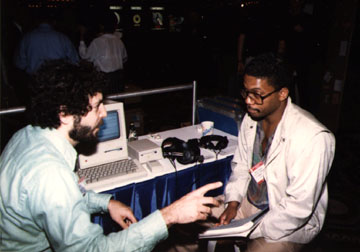
Describing the joys of Macintosh MIDI sequencing to Herbie Hancock, AES convention, New York, 1985
In 1998, I was asked by music publisher G. Schirmer to help realize the original, never-performed version of George Antheil’s 1924 Ballet mécanique, the premiere of which was performed at the University of Massachusetts Lowell in November, 1999. A recording of that performance is also available directly from me or through Amazon. The piece has since been performed some 30 times in Carnegie Hall, Symphony Hall and Jordan Hall (Boston), Davies Hall (San Francisco), The University of Victoria (B.C.), Baltimore, Columbus, Montreal, Belgium, Germany, New Zealand, Royal Festival Hall (London), Chicago, Nashville, and other cities. I programmed a robotic orchestra that performed the piece at the National Gallery of Art in Washington for nine weeks in 2006, and also at venues in Miami and New York. From 2003 to 2006 I wrote and produced a film about the Ballet mécanique and its history, entitled Bad Boy Made Good, which subsequently won several prizes and was shown on PBS television.

The Kurzweil PC88—I wrote the manual and helped design the MIDI implementation
In January, 2000, I joined the faculty of Tufts University, teaching courses in music for multimedia and electronic musical instrument design.
In November, 2000, I received an M.A. in independent study / music performance technology from Lesley University, Cambridge, Massachusetts. My thesis was titled “The Revival of George Antheil’s 1924 Ballet mécanique.” In 2010 I received my PhD from Tufts University’s Interdisciplinary Doctoral program. My thesis continued my previous work, incorporating considerable new research into both the score and the film of Ballet mécanique, and was entitled “The History and Technology of Ballet mécanique.”
In October, 2013, pianist Guy Livingston premiered a concerto-style edition of Ballet mécanique that he and I created at the Sinuston Fest in Magdeburg, Germany in October, 2013. That version has since been performed in Montreal, Boston, and Providence, RI.
I now teach full time at Tufts in the music, computer science, and mechanical engineering departments, as well as heading the school’s Music Engineering interdisciplinary minor program, and supervising all of the music department’s technical needs. I also direct the Tufts Electronic Music Ensemble and play bassoon occasionally in the university’s orchestra and wind ensemble.
Since 1991, I have been married to Sharon Kennedy, storyteller, educator, and Grammy-nominated recording artist, whose page is here.
